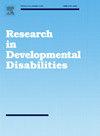从人工神经网络的角度探讨自闭症谱系障碍儿童的感官改变和重复行为。
IF 2.6
2区 医学
Q1 EDUCATION, SPECIAL
引用次数: 0
摘要
背景:限制性重复行为(RRB)和感觉处理障碍是自闭症谱系障碍(ASD)的核心症状。目的:本研究使用人工神经网络(ANN)分析和一种名为 "自动收缩图"(Auto-CM)的创新数据挖掘分析方法来研究这两者之间的关系,该方法可发现复杂变量网络(如生物系统)中隐藏的趋势和关联:对 45 名 ASD 儿童的照顾者(男 78%;女 22%;平均年龄 6 岁)进行了感官简表和重复行为量表(修订版)测试。问卷得分、临床和人口统计学数据均通过 Auto-CM 进行收集和分析,并绘制了连接图:得出的图谱所显示的主要关联证实了已知的 RBB 与感觉异常之间的关系,并支持感觉表型的存在以及 ASD 患者 RRB 与睡眠障碍之间的重要联系:我们的研究表明,ANNs的应用及其易操作性对研究ASD的RBBs和感觉异常非常有用,其目的是实现更好的个体化康复技术和改善早期诊断:行为和兴趣的限制性、重复性模式以及感觉阐述的改变是 ASD 的核心症状,它们对患者生活质量的影响众所周知。本研究有两大新颖之处:1)同时比较使用两种家长问卷(SSP 和 RBS-R),用于 RRB 和感官特征的改变;2)将 ANNs 应用于此类研究。方差网络是一种自适应模型,特别适用于解决非线性问题。虽然它们已被广泛应用于医学领域,但尚未被应用于 RRB 和一般感觉异常的分析,更不用说对 ASD 儿童的分析了。自动收缩图(Auto-CM)是第四代 ANNs 分析方法,应用于之前使用经典统计模型探索的数据集,证实并扩展了 SSP 和 RBS-R 分量表与人口学临床变量之间的关联。其中,低能量分量表被证明是该系统的核心枢纽;自伤行为分量表与智力残疾变量之间,以及睡眠障碍与各种 RRB 之间也出现了有趣的联系。在这一领域不断扩展的研究旨在指导和调节新兴的有针对性的个性化康复治疗。本文章由计算机程序翻译,如有差异,请以英文原文为准。
Exploring sensory alterations and repetitive behaviors in children with autism spectrum disorder from the perspective of artificial neural networks
Background
Restrictive repetitive behaviors (RRBs) and sensory processing disorders are core symptoms of autism spectrum disorder (ASD). Their relationship is reported, but existing data are conflicting as to whether they are related but distinct, or different aspects of the same phenomenon.
Aims
This study investigates this relationship using artificial neural networks (ANN) analysis and an innovative data mining analysis known as Auto Contractive Map (Auto-CM), which allows to discover hidden trends and associations among complex networks of variables (e.g. biological systems).
Methods and procedures
The Short Sensory Profile and the Repetitive Behavior Scale-Revised were administered to 45 ASD children’s caregivers (M 78 %; F 22 %; mean age 6 years). Questionnaires’ scores, clinical and demographic data were collected and analyzed applying Auto-CM, and a connectivity map was drawn.
Outcomes and results
The main associations shown by the resulting maps confirm the known relationship between RBBs and sensory abnormalities, and support the existence of sensory phenotypes, and important links between RRBs and sleep disturbance in ASD.
Conclusions and implications
Our study demonstrates the usefulness of ANNs application and its easy handling to research RBBs and sensory abnormalities in ASD, with the aim to achieve better individualized rehabilitation technique and improve early diagnosis.
Paper’s contribution
Restricted, repetitive patterns of behaviors and interests and alteration of sensory elaboration are core symptoms of ASD; their impact on patients’ quality of life is known. This study introduces two main novelties: 1) the simultaneous and comparative use of two parent questionnaires (SSP and RBS-R) utilized for RRBs and alteration of sensory profile; 2) the application of ANNs to this kind of research. ANNs are adaptive models particularly suited for solving non-linear problems. While they have been widely used in the medical field, they have not been applied yet to the analysis of RRBs and sensory abnormalities in general, much less in children with ASD. The application of Auto Contractive Map (Auto-CM), a fourth generation ANNs analysis, to a dataset previously explored using classical statistical models, confirmed and expanded the associations emerged between SSP and RBS-R subscales and demographic-clinical variables. In particular, the Low Energy subscale has proven to be the central hub of the system; interesting links have emerged between the subscale Self-Injurious Behaviors and the variable intellectual disability and between sleep disturbance and various RRBs. Expanding research in this area aims to guide and modulate an emerging targeted and personalized rehabilitation therapy.
求助全文
通过发布文献求助,成功后即可免费获取论文全文。
去求助
来源期刊

Research in Developmental Disabilities
Multiple-
CiteScore
5.50
自引率
6.50%
发文量
178
期刊介绍:
Research In Developmental Disabilities is aimed at publishing original research of an interdisciplinary nature that has a direct bearing on the remediation of problems associated with developmental disabilities. Manuscripts will be solicited throughout the world. Articles will be primarily empirical studies, although an occasional position paper or review will be accepted. The aim of the journal will be to publish articles on all aspects of research with the developmentally disabled, with any methodologically sound approach being acceptable.
 求助内容:
求助内容: 应助结果提醒方式:
应助结果提醒方式:


